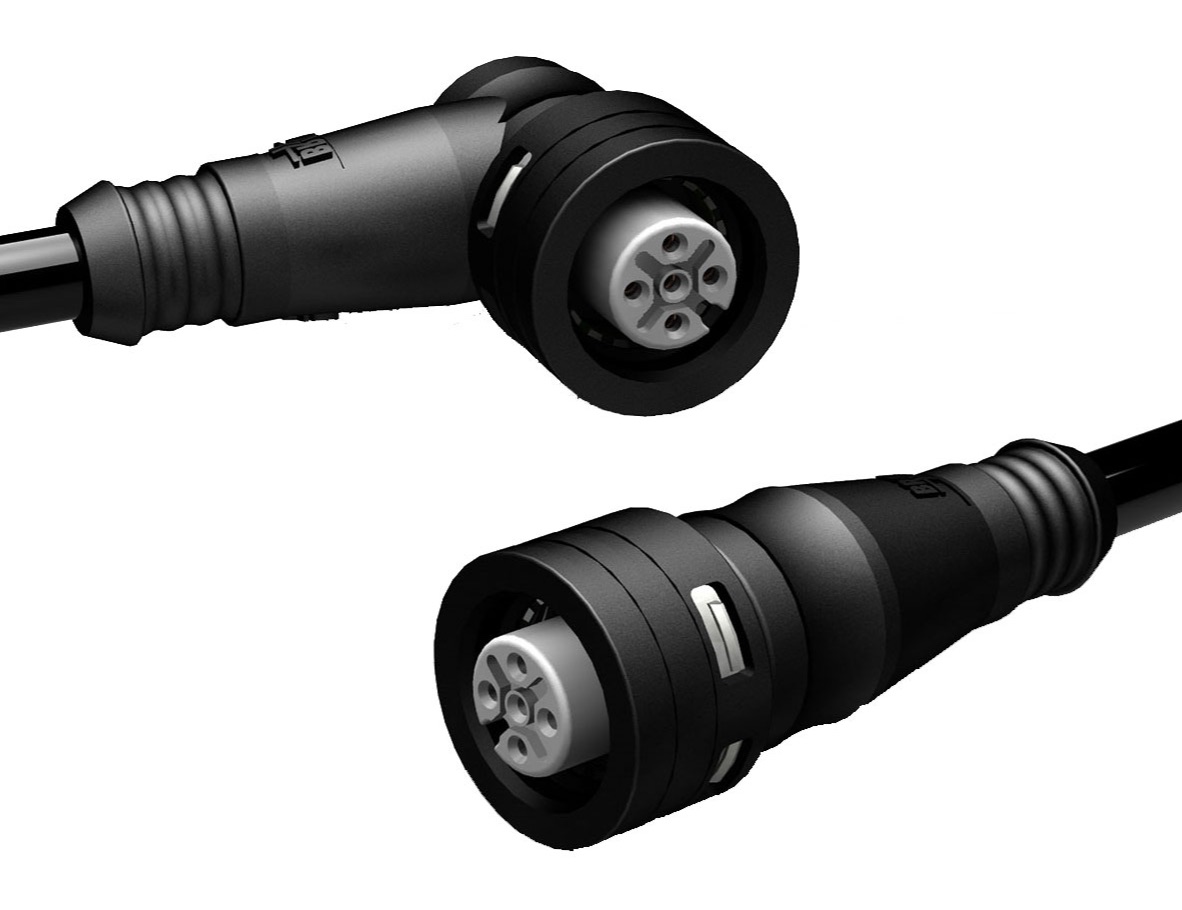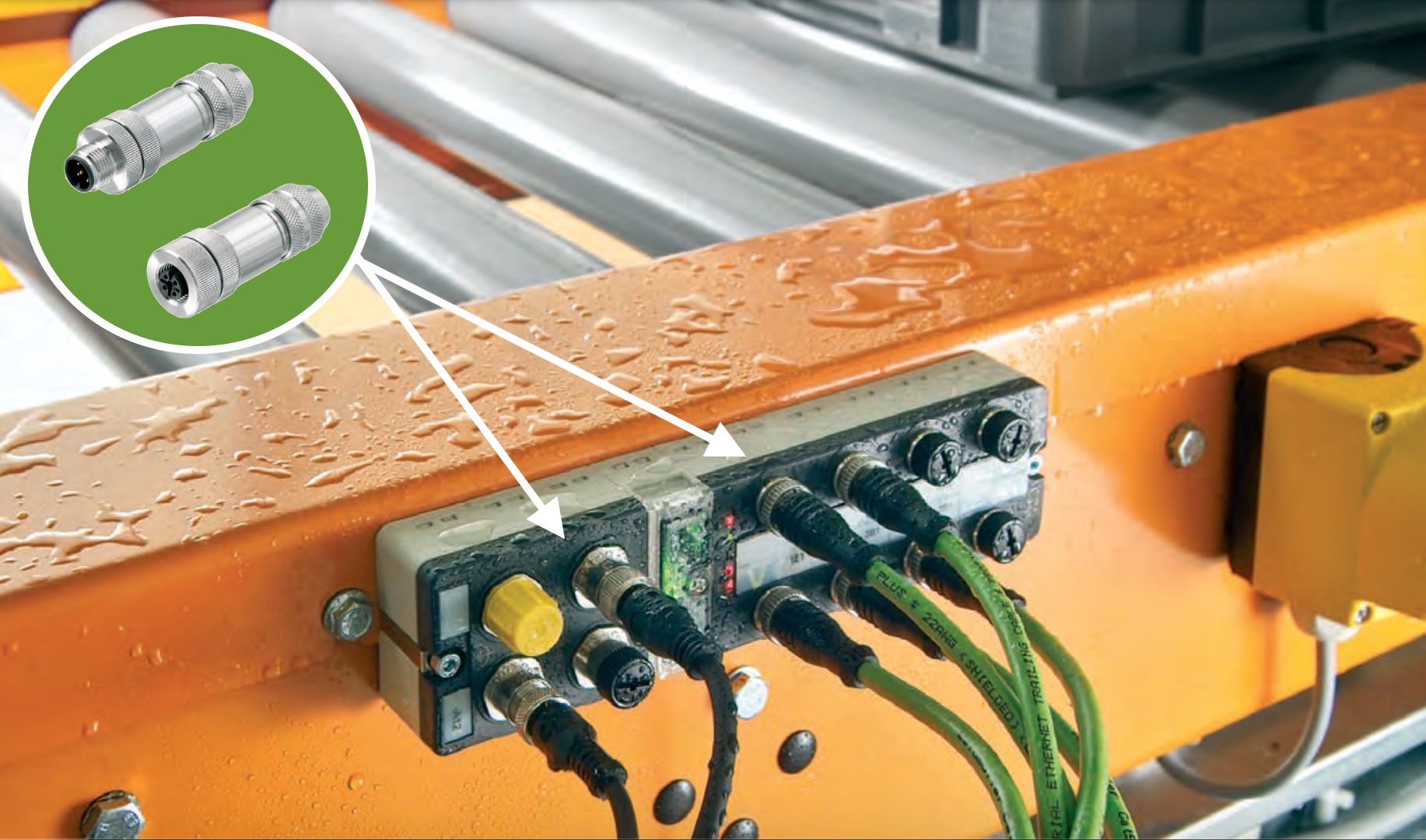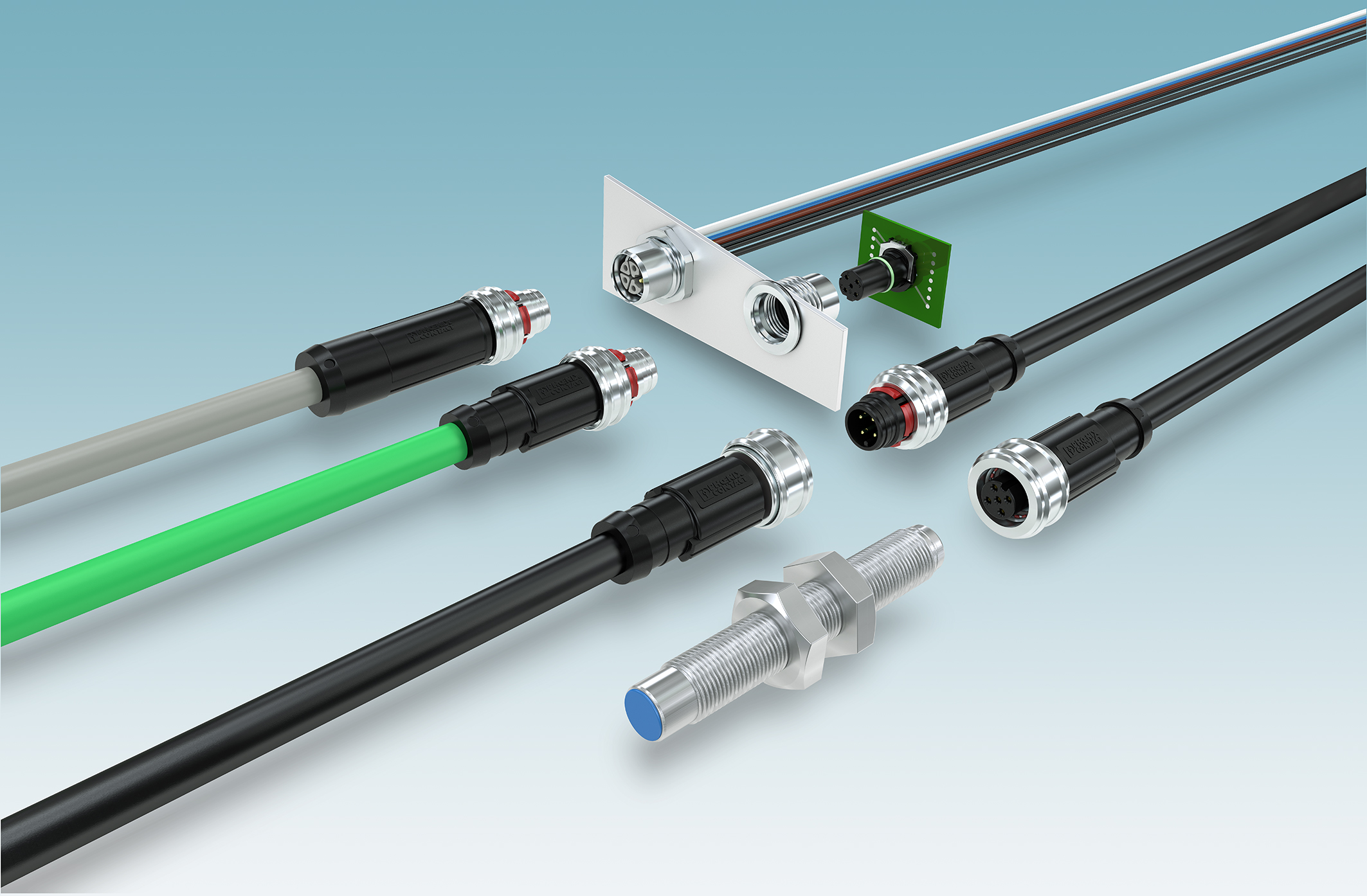A New Standard for Locking M12 Push-Pull Connectors
Specifying locking M12 push-pull connectors has become easier with the arrival of a unified standard that ensures compatibility across manufacturers.
Locking M12 push-pull connectors are a common choice for industrial and harsh environment applications due to their versatility, durability, ruggedness, and reliability even in high-vibration conditions. These sealed, circular interconnects have become a mainstay in many networks, delivering data and power to equipment and machinery, including heavy vehicles and rail networks. They are widely specified in factory automation applications, including industrial Ethernet and fieldbus networks and sensor connections.
For decades, many suppliers have offered proprietary variations of locking M12 push-pull connectors. This created a fragmented market that made it difficult for customers to specify locking M12 connectors, especially for system upgrades. In recent years, the trending implementation of connected technologies in manufacturing and factory settings has further increased the use of locking M12s in industrial networks and increased the pressure to create a standardized design for locking M12 push-pull connectors, which would give designers the same cross-manufacturer compatibility they already have with the standard screw-type M12.
Eight connector suppliers with established M12 product lines — binder, HARTING, Molex, Phoenix Contact, Weidmüller, CONEC, Escha, and Murrelektronik — joined forces to create a consensus and develop a standardized, fully featured design for locking M12 push-pull connectors. Their work is represented in the standard known today as IEC 61076-2-010;2021, which was released in 2021. This video by Phoenix Contact offers a demonstration of the connection process for the new standardized M12 design, and Connector Supplier spoke with Andrea Briggs, product manager at Weidmüller, and Nathan Owens, product marketing manager at Phoenix Contact, to learn more about this important new standard.
Eight companies teamed up to deliver the new M12 standard. What inspired this effort?
Weidmüeller: The topic of locking M12 push-pull connectors with cross-manufacturer compatibility was brought to the IEC by the German Standardization Group (Working Group 651.1.1 Circular Connectors), which includes several large manufacturers. The IEC uses standardization committees within relevant countries to assist in the creation of new standards. Through the collaborative forum the IEC created, the new standard was born.
Phoenix Contact: The connector industry has been trying for over 15 years to find a fast-locking mechanism for M12 circular products. The challenge has always been to maintain backwards compatibility with the full-threaded version. Every manufacturer came out with their own form factor that was able to mate with a full thread; there were just a lot of different ideas. When Molex released its Brad Ultra-Lock Connection System, that was the first time that the push-pull approach became a reality.

Last year, Molex released the Brad M12 Ultra-Lock 2.0 Female Cordsets, which meet the IEC 61076-2-010:2021 standard, provide an easy-to-assemble interface, and deliver increased productivity and cost savings while surpassing the performance and reliability of traditionally threaded connectors.
There was no way to integrate it into an I/O box for sensor collection without adding costly receptacles above the box because the locking mechanism always caught on the outside. That product also lacked the ability to make cable-to-cable connections because the locking mechanism was external and, as such, required an adapter.
The new locking M12 standard encompasses some of the benefits of the Ultra-Lock, but it also has external and internal locking mechanisms and a push-pull design, so there’s no need for additional tooling.
What features and advantages set the standardized version of this connector design apart from earlier locking M12 push-pull connectors?
Weidmüeller: All well-known M12 variants are possible with the IEC 61076-2-010 standard, including field attachable, molded, and device connectors. However, there are a few main differentiators:
- The new M12 push-pull contour also has a full M12 thread, making the push-pull and screw locking M12 connectors interchangeable.
- Flying field couplings between M12 inner push-pull connector designs and M12 outer push-pull designs are now possible because both types are standardized in IEC 61076-2-010:2021.
- All known M12 codings from previous standards (IEC 61076-2-101/ -109/ -111/ -113) can also be used in the IEC 61076-2-010:2021 standard.
Although the newly standardized locking M12 push-pull connectors are new products based on a new standard, the insides are still based on the familiar M12 codings (IEC 61076-2-101/ -109/ -111/ -113). So, designers should be secure in the fact that the inside is unchanged. There is only an upside to this standardization, and that is the benefit of a push-pull locking mechanism on the outside.
Do any of the previous locking M12 versions have potential for continued utility or preference over the standard?
Phoenix Contact: We have some customers that are still are on our [pre-standard] Speedcon M12 platform, and that’s a must-have for them. But we’ve removed most of those older products from our catalog in preparation for the new locking M12 push-pull standard. I think when those same customers see the advantages of these new connectors, the whole M12 market will be on the new push-pull standard. That will take some time and awareness, though, so it may be 10 years before we see full adoption.
Weidmüeller: We expect that the locking M12 push-pull connectors created prior to the standard will have limited utility. In the long term, it makes no sense for a manufacturer to maintain products that do not adhere to the standard and manage two different versions of the same solution. However, if we are talking about the new push-pull design replacing M12 screw-type connectors, then we believe that there is space for both to flourish in the market. There are still plenty of applications in which screw connections are adequate or even preferred over more costly push-pull solutions.

Screw-type and other M12 connector variants, such as those available from Weidmüeller, may be the best choice for cost-conscious applications that don’t benefit from the installation benefits the new standard provides.
What impact does the standardization of locking M12 push-pull connectors have on other existing M12 products or variants available on today’s market?
Weidmüeller: The impact of standardization is a positive one. It allows manufacturers to appeal to a broader customer base due to the interchangeability the standard provides, which also better serves customers and their unique application challenges. In addition, it helps promote widespread market acceptance of the new product design.
Within IEC 61076-2-010, it is possible to offer the same well-known M12 variants, materials, and cables from the existing M12 standards (IEC 61076-2-101/ -109/ -111/ -113), but they are not defined in the standard. The standard defines the mating-interface, general technical data, and reliability, but not the materials and raw cables.
How will cabling architectures be impacted by the new standard?
Weidmüeller: There will be a positive impact on cabling architectures. One big advantage of the IEC 61076-2-010:2021 standard is, if it’s implemented in devices, users can choose to use new locking M12 push-pull connectors or standard screw-type M12s, as both types will fit in the same device connector.
Phoenix Contact: It’s going to bring the versatility that we’ve always wanted for the installation side of the business. It also increases reliability by eliminating the potential for user connection errors with the locking mechanism and eliminating the need for the specialized torque tools that were previously required to make sure you set the coupling nut properly to guarantee the IP rating. The standard also makes it a little bit easier for device and I/O peripheral manufacturers to develop new products given that the new locking M12 push-pull connectors are universally compatible both screw and push-pull systems, which means they no longer have to go with a proprietary solution from one specific supplier.
What markets and applications are driving growth or demand for locking M12 connectors?
Weidmüeller: Any application can benefit from locking M12 push-pull connectors but it can be more costly to specify a push-pull versus a regular screw type. If a fast, secure connection is required in an application where space around the connector is limited, then the push-pull would be the ideal option. Designers should evaluate the application requirements, installation environment, and operating conditions to make this decision.
The new locking M12 push-pull solution is driven by applications where fast and secure connections are needed, as they mate with a simple push and click — no tools needed. They are also ideal for applications where there’s limited connector mounting space and torque tools won’t fit. Also, now that it has a standard associated with it, more customers will accept the technology and be more open to using push-pull M12 products.
How will the standardized locking M12 push-pull product compare in terms of costs to the screw-type M12 and previous push-pull variants?
Phoenix Contact: Our Speedcon push-pull was set at the same price point as our full-thread M12s. We just had one additional operation to segment that full thread, and we didn’t charge for it. But most other fast-locking M12 products did have some premium, around 30% to 50% higher, and there would also be additional tooling costs with some configurations. I haven’t yet seen the pricing for the new standard product design, but I think it will be more in that 5% to 15% premium range. Plus, the new design also saves labor costs and time over screw-type solutions.

Phoenix Contact’s M12 device connectors with a push-pull fast locking system deliver cross-manufacturer compatibility, convenient and secure connections, and clear feedback of proper mating. These connectors spring back if they aren’t snapped into place correctly and are safety shielded, available with IP65 and IP67 sealing, and ruggedized for railway applications with high shock and vibration loads.
Why would companies that have proprietary solutions want to become involved in standardization? What is the benefit to them and their customers?
Weidmüeller: Standardization appeals to a broader customer base. Rarely do customers enjoy having to dial into a proprietary solution, as it limits their supply base and is not without risk. So, for manufacturers, buying into standardization is a good thing to do. Customers are more trusting of products that adhere to standards and enjoy having a greater choice of manufacturer to go to. It also fosters healthy market competition.
Phoenix Contact: There’s definitely been a major change over the last 10 years that has led to the electronics industry understanding that you cannot be sole-sourced, because if that one supplier falls short, there is no other option. So, for trending technologies like single-pair Ethernet connectors, locking M12 push-pull connectors, and the new M8 D-coded connectors, leading manufacturers are happy to collaborate on the standardization process to make sure there’s a common platform that describes the interface and ensures it’s intermateable between manufacturers, so it’s easier to design in. From there, suppliers can go and create their own unique selling points or features that enhance the standard design.
Like this article? Check out our other M12, Circular Connector, and Standards articles, our Wire & Cable Assemblies and Industrial Market Pages, and our 2021 and 2020 Article Archives.
- State of the Industry: 2022-2023 Connector Sales - April 16, 2024
- Amphenol is On a Roll - April 2, 2024
- Nicomatic Proves That Two Heads are Better Than One - March 26, 2024





